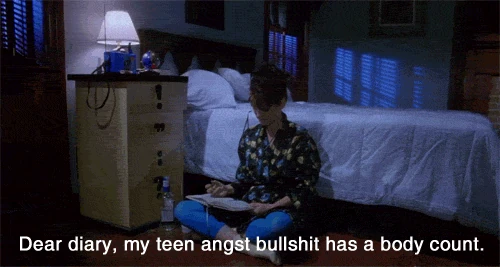(A version of this appeared in Scroll.)
Do
you remember where you were when your life hit a crossroads? I do.
For
a brief period, which felt like eternity at the time, I was bullied.
It wasn't even the dramatic stuff you see on TV or hear about, it was
mostly just occasional put downs (“you're so ugly”) or exclusions
(not being invited to a party everyone else was.) It wasn't a big
deal, and yet, it was the only deal. My life was consumed by this—I
was about thirteen, a difficult age anyway—and I did so badly at
school that I had to repeat the year. This was when the crossroads
happened: I begged to go somewhere else for school, my parents
agreed, and I was sent off to boarding school, where I made the first
tentative steps at becoming happy with being myself again. I guess
some inner reserve of mental strength I didn't know I had was keeping
me afloat—I was deeply unhappy, in the depths of despair and yet, I
still welcomed each new day as the gift it was.
Reading
(and watching) Thirteen Reasons Why
reminded me a little of that time. Every year, around this time of
the year—CBSE results, exam time—I read about teen suicides. In
this age of live streaming, we can even watch suicides, people
broadcasting till the very end. Though Thirteen Reasons Why
(the book) was published in 2007, way before live streaming was even
dreamt of, the victim, the girl, the second narrator in the book,
Hannah Baker, broadcasts her own death on thirteen tapes, naming and
shaming the people who drove her to this decision.

The
TV show is a bit more disturbing. While in the book, the boy
listening to the tapes; Clay; thinks to himself several times that
Hannah could have asked for help, in the show, the shades of grey are
less defined. Hannah is hounded with relentless bullying that would
make anyone break down, painted in TV screen colours, lingering
lovingly on each slap, on each sexual assault. In the book, Hannah's
parents are a little absent, all-absorbed in their business, but in
the show, her parents are frequently present, talking to her, eating
together and yet, she never turns to them. In the book, Hannah takes
some pills, the narrative doesn't go deeply into how she dies, but
the show has the camera pause on her scared face, her trembling
fingers, the lift of the razor as she slashes at her wrists and the
blood pumping out of them. (That's not a spoiler, you already know
that she dies in the end, don't you?)
A
while ago, Instagram banned the use of hashtags that promoted
anorexia, like #thinspiration or #proana. It didn't work the way the
social media site might have wanted it to: people began to modify
their hashtags, like for example, #thinspooo instead of the banned
#thinspo. At least they have a dedicated section in their help centre
where they address what you can do if you see someone posting threats
of suicide or self harm. (You can report the post and also share
links they've provided of suicide helplines.) But after reading (and
watching) Thirteen Reasons Why,
I saw it as a sort of glorified suicide video, except it was
pretending it was not. At least in the book, the common markers of a
suicidal individual are spelt out (they change their appearance, they
start giving away their things), but at the end of the show, you are
left feeling as despairing as one imagines the characters must be
after listening to the tapes.
In a survey done by the WHO in 2015,
India is one of the top 25 most suicidal countries in the world. 17%
of all world-wide suicides are Indian, and our rate of suicide for
women is the sixth highest in the world. Hindustan Times carried
a story
with an alarming statistic: every hour, one student commits suicide
in India. For not quite the same reasons as Hannah: these suicides
are usually related to academics and failing exams.
But books about teen suicide (few
and far between) usually deal with love or bullying or some such
trouble, starting all the way from Romeo and Juliet, the original
suicidal teens. Maybe that's why I'm somewhat disappointed with
Thirteen Reasons Why.
I wanted it to be more... something. More inner thoughts and less
“this is why it happened.” More about the numbness that hits
people with depression, teens more than others. I wanted it to
address the big black bird of despair that settles over their entire
lives. I wanted it to talk about how it feels like an effort to just
wake up and face the day. The book makes it too neat—there was a
girl, people bullied her, she killed herself. Bullying is awful, a
lot of people are driven to suicide through bullying alone, but there
is a step three in the middle where your brain says, “Anything
would be better than this. Death would be better than this.”
Thirteen Reasons Why
touches on that just briefly and towards the end, not going much into
how a person who was upbeat and cheerful just three chapters ago
could become so hopeless.
That's the teen suicide book—and
show—I'd like to see.




No comments:
Post a Comment
Thanks for your feedback! It'll be published once I approve it. Inflammatory/abusive comments will not be posted. Please play nice.